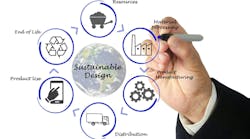Smart factories are green factories: How green product-lifecycle management is boosting sustainable manufacturing
By Nisar Ahamad, Americas sustainability lead—energy, utilities and chemicals, Capgemini Engineering
Increasing pressures to decarbonize are affecting all sectors, but perhaps none as much as manufacturing. Spiraling energy costs, supply chain efficiencies, waste reduction, brand reputation, customer demand and regulatory compliance are all factors that signify the business imperative toward sustainable manufacturing.
Greenfield sites are able to be designed from scratch with sustainability goals in mind. But for the many brownfield enterprises with older, legacy locations that need to be digitized, a pressing challenge arises: how can they facilitate green operations while also driving process efficiencies and bringing these sites into the modern era?
They can start by updating equipment, utilizing reusable materials to align with the circular economy, and reducing waste in the overall manufacturing process.
The good news is that any digital-transformation initiatives in manufacturing can—whether directly or indirectly—lead to sustainability savings. These savings, in turn, lead to better business all around. By striving to build an intelligent, unified approach to digitizing brownfield sites, businesses can achieve sustainability savings and drive better KPIs at the same time. Key to achieving this is green product-lifecycle management (PLM)—a holistic approach to the manufacturing floor that includes Intelligent Industry and digital transformation.
The ‘Five Cs’
The ‘Five Cs’ (connect, collect, collaborate, correct, control) are the necessary phases for businesses to make the most of all their existing and new assets that are being deployed. The Five Cs approach can deliver better operational efficiency in plants and, therefore, improve energy efficiency and waste reduction.
· Connect means building a holistic view of your assets, while standardizing and integrating them. Simply put—connecting all the equipment and assets on a factory floor. A key challenge in the manufacturing landscape for many enterprises is that their systems are siloed, federated or bespoke. These systems are custom solutions designed for a very specific need, which can often lead to thousands or tens of thousands of applications running across the full estate. This is neither scalable nor maintainable in a digital world and means that businesses are failing to achieve the maximum value of productivity or energy efficiency from their equipment. There are peripheral green gains to be made here, too. Digitizing all processes into manufacturing-execution systems, the computerized systems that document the factory floor equipment, is an easy win for going paperless. Think of the thousands of hard paper configuration manuals for equipment or assets. By digitizing these with appropriate technology, an organization reduces reliance on paper, but also makes life easier for employees by creating searchable documents in one location.
· Collect involves aggregating data to help organizations make more informed decisions about what actions they should take. When all the data is unified in one place, better judgments can be made about the efficiency of machines and processes. There is additional visibility into how the factory floor itself operates; by leveraging this data, plant operators can rethink the amount of time employees need to spend on the factory floor. This also allows for additional savings around powering HVAC systems, for instance, if fewer people are required for fewer hours.
· Collaborate means that once the data has been collected, manufacturers can build predictive models and bring in various insights from the field. Because they are armed with better data about any issues occurring, this information helps them to coordinate and reduce rounds—on-site visits by operators and technicians, which can quickly add up to cost and energy savings. For instance, a legacy model would typically involve thousands of plant visits in a single year to identify an on-site issue. Cutting this down with predictive analytics can translate to millions in saved costs, as well as a reduce carbon footprint if less site visits are required.
· Correct and control are fairly self explanatory, but in short, they involve analyzing data and course correcting based on these insights to further refine outgoings and improve energy efficiency, process improvements and waste reduction.
How can organizations achieve the Five Cs?
The first step is computerization, bringing plants into the digital age with modern equipment. Connectivity is the standardization and integration of systems so that they are connected across site lines and plants, which may involve adding sensors to legacy equipment. This leads in to establishing visibility, which could cover anything from production efficiencies to greening operations.
Once the data is visible, the fourth step is transparency, that is, establishing how reliable the data is—whether or not it is a single source of truth. Then, if it is accurate, unified data, organizations can start work on building capabilities for taking actions fast, before undesirable events occur—this is predictability. Finally, adaptability is the stage in which a manufacturer enjoys highly matured, digital systems across all ecosystems that are self-orchestrated, with automated decision-making and minimum manual intervention.
What does success look like?
A smarter, greener factory will be equipped with a plant-control tower, capable of enhancing real-time contextual decision making, and with integrated visibility across planning, supply chain, and manufacturing functions. Meanwhile, agility will be baked into day-to-day operations through digital-twin simulations, where production lines are optimized before products are introduced.
A manufacturer recently wanted to accelerate its digital-transformation strategy to unleash all the capabilities of a digital twin. They needed to modernize their legacy-document-management system to create a single source of truth. This was achieved by leveraging a multi-step process. First, by integrating existing engineering-design tools and standardizing engineering data models. Then, by integrating the application to a material-management system and creating a reliability solution; lastly, by controlling and correcting the operational parameters with a distributed-control system.
Taking these steps enabled the project to be managed, and also meant that the solution could be re-engineered along with leading technical design, application development, testing, integration, and further customer assistance. By replacing the existing instrumentation and control command to the new system, renovating the IT and coding the standards of the project, the manufacturing facility now enjoys end-to-end digital transformation, an open-data ecosystem to drive operational efficiency, improved worker safety, supply chain transparency, and environmental compliance.
Factory machines can be embedded with advanced, predictive analytics to improve operational workflow—reducing scrap with predictive quality capabilities, as well as process and energy optimization. Workers can be equipped with AR/VR technologies to empower them to make better-informed decisions more quickly and more autonomously. Additionally, monitoring and applying overall plant data can help to guide a more intelligent automation process, eliminating repetitive manual tasks from the workforce. All of this is overseen with operational intelligence that values rapid escalation and resolution, as well as close monitoring of execution down to individual workstations and machines.
A holistic green project-lifecycle management approach containing all of these elements will help legacy manufacturers bring brown sites into the digital age, while reducing carbon emissions through better efficiency. The numbers will speak for themselves—and show that a smart factory is a more sustainable factory.



